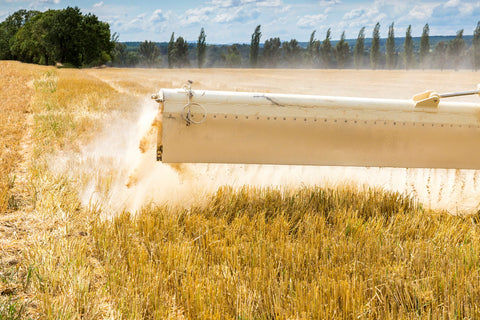
What Are Plant Growth Regulators?
I don't know about you, but to me the phrase "plant growth regulators" makes me think of 6th grade science and photosynthesis. It seems a logical connection that a plant growth regulator could be referring to the sun or the amount of water a plant needs in order to grow. Unfortunately, that is not the case since it refers to something a bit more ominous.
The phrase "plant growth regulators" can be interchanged with "plant hormones" or phytohormones. They refer to numerous substances that profoundly influence growth and differentiation of plant cells, tissues and organs. These substances can be natural or synthetic and they are - according to the Environmental Protection Agency - used "to accelerate or retard the rate of growth or maturation, or otherwise alter the behavior of plants or their produce." They are sprayed on crops during the growing season just like herbicides or fungicides.
Some herbicides are actually considered plant growth regulators when they are applied in low amounts to crops. When high amounts of a chemical is used - then it is considered an herbicide. "As all herbicides act on pathways or processes crucial to plants, in an inhibitory or stimulatory way, low doses of any herbicide might be used to beneficially modulate plant growth, development, or composition." Glyphosate, for instance, has been used as the main plant growth regulator to ripen sugarcane in Louisiana since 1980.
Common Uses of Plant Growth Regulators
*Affect Root Formation
*Manipulating Yield Potential
*Plant Stress Protection
*Ornamental horticulture (growth of decorative flowers)
*Post harvest life of ornamentals
*manipulating Fruit Development and Storage Quality
*Citriculture (the growing of citrus fruits)
*Reducing Fruit Drop (so they drop at the same time)
*Bloom Thinning Strategies (so as not to strangle crops)
Why Are Plant Growth Regulators Used on Wheat?
Plant growth regulators are typically used on wheat to help prevent lodging which is the bending over of the stems near the ground caused by heavy rain or hail. Lodging is an expensive problem for farmers who are constantly pushing for the highest yields possible. Lodging can cause a yield reduction of as much as 50% which would make the use of lodging-preventative chemicals tempting - if not a necessity to a farmer. These regulators can retard the growth of the stock making it much shorter than if it were left alone.
Cycocel and trinexapacethyl are typically used on cereal grains such as wheat and are usually applied in the early stages of growth. Some of these plant growth regulators can increase wheat yields by 5 to 10%.
Interestingly enough, L Tryptophan (the amino acid in Turkey that makes you want to sleep after your big Thanksgiving dinner) when applied to fields with fertile soil can significantly increase shoot growth and grain yield in wheat.
The idea is to manipulate the crops by adding plant growth regulators at specific times to help defend it against elements that would harm or reduce wheat yields. This means that a wheat crop may have been subjected to several different plant growth regulators during the growing season.
Could these Plant Growth Regulators be Making Us Sick?
The answer is - I can't find absolute evidence about what ingesting plant growth regulators can do but let's take a look at what we can find.
It is important to note that there are different rules and regulations for the use of plant growth regulators all over the world. In fact, the approved uses of them vary from country to country and here in the US - from state to state. Some plant growth regulators are approved in all states and some in just a few. Additionally, it seems that some of these chemicals are only technically approved for different uses. For example, a chemical may be approved in Louisiana as an herbicide but not as a plant growth regulator.
It is hard to find research or articles discussing how consuming grains treated with plant growth regulators can affect our health. One thing that exists in abundance, however, is the potential harm that can come to field workers who are exposed to them. According to the California Department of Pesticide Regulation - plant growth regulating chemicals can cause eye injury, skin irritation, fatal injury if swallowed or contact through the skin. Additionally, some of these chemicals can be hazardous to bees, they can be corrosive, flammable and they can potentially drift and cause harm to plants that were untreated. Keep in mind, these chemicals can get into the environments as easily as through the wind and the rain.
Now, I don't know about you, but I get a little nervous reading that list and then thinking about how these chemicals are applied to fields containing.... our food.
What to Know About Berlin Natural Bakery
We import all our of spelt grain from Germany because of the purity of the Heirloom variety we found there. This Heirloom variety is protected which means there are extremely strict growing standards that are required to be met. Routine farm inspections take place in order to ensure that the standards are met which include absolutely no use of pesticides or herbicides.
After each harvest, the spelt grain is tested independently at a University in Germany. Those tests must show that the grain has absolutely no pesticides, herbicides or fungicides in it. This is important because one of the risk factors mentioned above is that plant growth regulating chemicals can potentially drift and affect crops and fields that haven't been treated with them.
We believe that it is our responsibility to do what's right even when it isn't easy. We take that belief with us when it comes to our growing standards and our commitment to being free from potentially harmful chemicals. We have made it our mission to worry about and develop these standards over the last 30 years so that you don't have to.
Stay Tuned!
If you are surprised about how much science goes into a loaf of bread - brace yourself because we have quite a bit more information for you, coming up!
Next up on the agenda, we're talking about collection bins that store grain, the many chemicals that are commonly applied to them and how that could be affecting our health.
Until next time
Sources:
http://ucbiotech.org/resources/biotech/talks/misc/regulat.html
http://www.bioone.org/doi/abs/10.1614/WS-D-09-00028.1?journalCode=wees
https://www.lsuagcenter.com/MCMS/RelatedFiles/%7B52252AD6-8700-4818-971C-3558F094E1A2%7D/12-Plant-Growth-Regulators.pdf
http://prairiesoilsandcrops.ca/articles/volume-6-2-print.pdf
http://www.agweb.com/article/high-yield_wheat_tips_to_avoid_lodging/
http://msue.anr.msu.edu/news/using_palisade_plant_growth_regulator_to_improve_wheat_performance
http://soilcrop.tamu.edu/agrilife-extension-expert-cautious-about-plant-growth-regulators-for-wheat/
http://plantchemical.com/what-is-a-plant-growth-regulator-is-it-harmful-to-human-body/?print=pdf
http://www.cdpr.ca.gov/docs/license/grthreg.pdf
















Comments
0 Comments